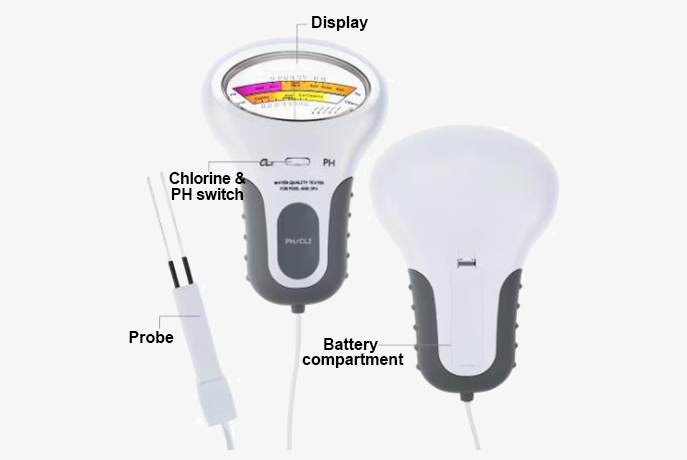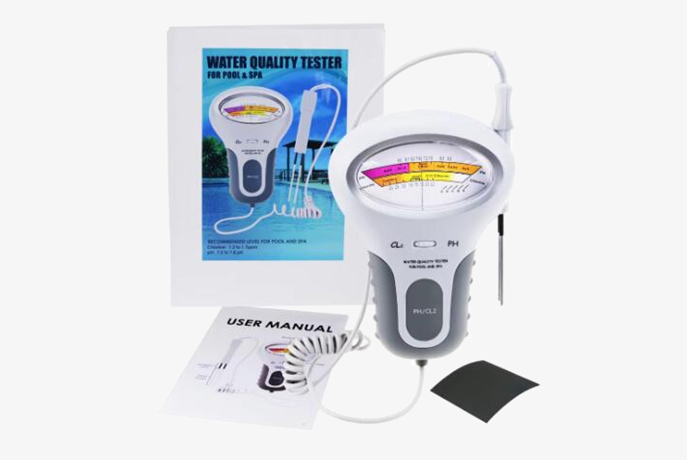The electronic two in one water quality analyzer uses the national standard DPD spectrophotometric method, it gives you useful info to adjust chlorine and pH of your pool accordingly, replacing traditional visual colorimetry with colorimetric monitoring to eliminate human error and significantly improve measurement resolution.
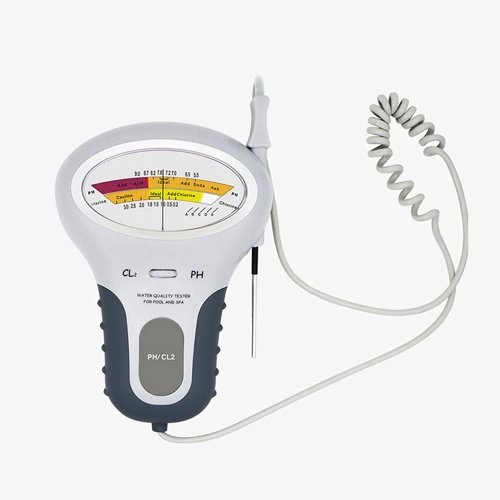
Portability and Ease of Use Electronic pH & Chlorine Water Quality Tester
- Probe Slot: The probe can be inserted into the instrument when not in use, making it easy to carry and store.
- Extendable Telescopic Cable: An elastic extension cable allows for increased reach, suitable for measurements in various environments.
- pH/CL₂ Switch Button: A 2-in-1 water quality tester allows convenient switching without needing to change devices.
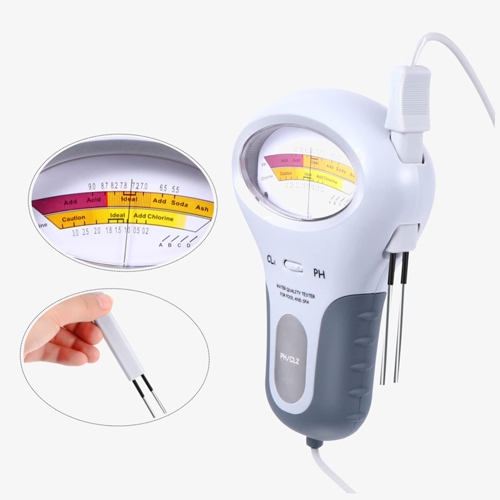
Accurate Measurement and Long-lasting Power
- Battery Type: Operates on PCAA batteries, providing long-lasting power and stable performance.
- Dual-Probe Detection: The dual-probe design enables faster and more accurate detection of chlorine levels and pH values in water.
Applications
SISCO electronic 2-in-1 water quality tester is widely applicable across various settings, including chlorine and pH testing in pools, spas, and hot springs to ensure safe and healthy water quality. It is also used for accurate residual chlorine measurements in hospital wastewater to support compliant discharge. Suitable for self-monitoring by wastewater-producing enterprises, it helps meet environmental standards. Water treatment plants use it for routine residual chlorine monitoring to ensure safe drinking water, while in the wastewater treatment industry, it aids in monitoring and optimizing water treatment processes. Its versatility and reliability make it ideal across multiple industries and applications.

Hot Spring

Spa
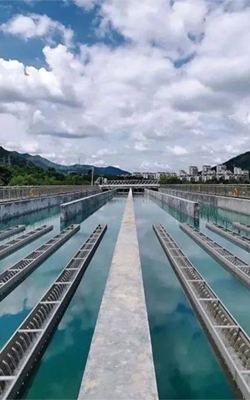
Water Supply Plant

Swimming Pool
How to use

1. Testing Residual Chlorine (CL₂)
- Slowly turn the knob left towards the "CL₂" direction until the pointer aligns with the letter "C" for calibration.
- Prepare a 1.5 ppm residual chlorine standard solution. Place the metal rod in the measuring cup up to the black mark, and the pointer will slowly move. Wait until the pointer stops moving to take the reading. Clean the metal rod after use.
Note: For CL₂ testing, the battery must be installed. For pH testing, remove the battery for more accurate results.
2. Testing pH
- Rub the metal rod back and forth with fine sandpaper 3-5 times to remove any dirt, then wipe it clean with a paper towel or cloth.
- Turn the knob towards "PH" until a clicking sound is heard (turn the knob towards "PH" until it stops moving).
- Place the metal rod in the solution for pH testing and wait until the pointer stops moving before taking the reading. Clean the metal rod after use.
Dimensions (inch/cm)
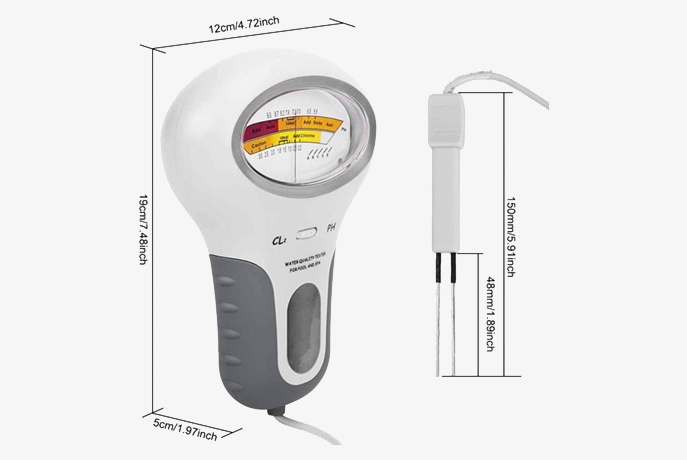
Details
Packing List
- 1 x Water quality meter
- 1 x User manual
Q1: What can cause inaccurate readings of pH&chlorine water quality tester?
A1: Inaccurate pH and chlorine readings in water quality testers can be caused by several factors, including dirty or damaged sensors, improper calibration, temperature fluctuations, and contamination from residual chemicals. For instance, if the sensors aren’t cleaned regularly, oils or minerals from the water can build up and interfere with readings. Additionally, expired test reagents or low batteries can reduce accuracy in digital testers, while electrical interference from nearby devices can also lead to fluctuating readings. Ensuring regular maintenance, proper calibration, and a clean, stable testing environment are key to obtaining reliable results.
Q2: What parameters can a water quality tester measure?
A2: A water quality tester can measure several key parameters to assess the safety and purity of water. Common measurements include Total Dissolved Solids (TDS), which indicates the concentration of dissolved substances like minerals and salts; Electrical Conductivity (EC), which reflects the water’s ability to conduct electricity and indirectly shows the level of ionized substances; and pH levels, which determine the acidity or alkalinity of the water. Some testers also measure temperature, as it can affect other readings, and dissolved oxygen (DO), which is critical for aquatic life. Additionally, advanced testers may monitor turbidity, chlorine levels, and specific contaminants like nitrates or heavy metals. These parameters together give a comprehensive overview of water quality.
Q3: What is a good chlorine level and pH reading for pools and spas?
A3: Maintaining proper chlorine and pH levels is crucial for the safety and comfort of swimming pools, hot tubs, and spa water. Chlorine, which disinfects and controls bacteria, should be kept at 1.0 to 3.0 ppm (parts per million) in standard swimming pools, while hot tubs and spas require a higher range of 3.0 to 5.0 ppm. The increased temperature in spas and hot tubs can reduce chlorine effectiveness, so regular testing is essential. Keeping the chlorine within these ranges ensures effective disinfection and helps prevent waterborne illnesses, while avoiding the discomfort of overly chlorinated water.
Alongside chlorine, the pH level of pool and spa water is equally important. A balanced pH (7.2 to 7.6 for pools and 7.2 to 7.8 for spas) ensures that the water is neither too acidic nor too basic, promoting comfort and protecting equipment. Water that is too acidic can cause skin and eye irritation and corrode pool surfaces, while water that is too basic may reduce chlorine effectiveness and cause scaling on surfaces. Regular monitoring of both pH and chlorine levels is key to ensuring that pool, spa, and hot tub water remain safe, comfortable, and in top condition for users.
Tips: How does a pH & chlorine water quality tester work?
A pH and chlorine water quality tester works by using specialized sensors or chemical reagents to measure the concentration of hydrogen ions (for pH) and chlorine levels in water.
pH Measurement: pH sensors use a glass electrode that is sensitive to hydrogen ions in the water. When immersed, the electrode detects the activity of these ions, which produces a small electric voltage. This voltage is then measured by the tester and converted into a pH reading, indicating the water’s acidity or alkalinity. Digital testers may have automatic temperature compensation (ATC) to adjust for temperature fluctuations, ensuring more accurate pH readings.
Chlorine Measurement: Chlorine levels are measured using an electrode or colorimetric method. In digital testers with an electrode, the sensor detects the free chlorine concentration in the water and converts it into a digital reading. In colorimetric tests, a reagent is added to a water sample, producing a color change based on chlorine concentration, which can then be measured with a photometer or visually compared to a color chart.
Thank you for buying industrial test and measurement equipment on SISCO.com, all products sold by SISCO and the partner cover a 12 months warranty, effective from the date of receiving the products.
What is covered?
SISCO is responsible for providing free spare parts, and free technical support to assist the customer to repair the defective products until the problem is solved.
What is not covered?
- Product purchased from anyone other than a SISCO store or a SISCO authorized reseller.
- Expendable parts.
- Routine cleaning or normal cosmetic and mechanical wear.
- Damage from misuse, abuse or neglect.
- Damage from use of parts other than SISCO approved.
- Damage from use outside the product’s usage or storage parameters.
- Damage from use of parts not sold by SISCO.
- Damage from modification or incorporation into other products.
- Damage from repair or replacement of warranted parts by a service provider other than a SISCO authorized service provider.
- Damage caused by the application environment not meeting the product usage requirements and the failure to perform preventive maintenance.

